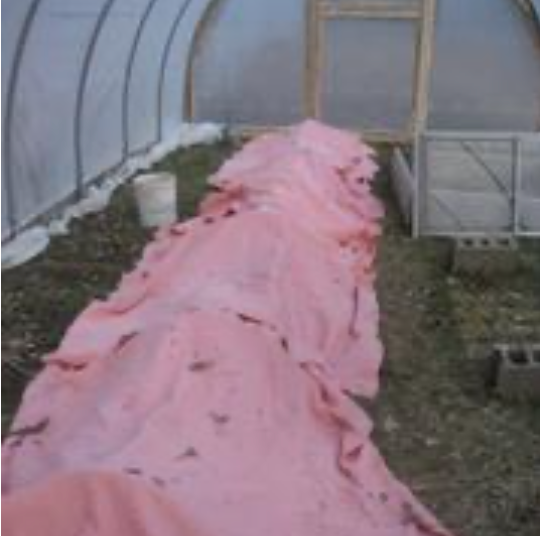
Tucked-In Beds
As usual, March has shaped up to be a real roller-coaster of weather--from several-day stretches of balmy sixty degree temps to cold snaps with frigid nights. The past few nights have been quite cold for late March, with temperatures dropping to around 15 degrees. And while our plants are happy as can be to enjoy the warmth of the greenhouse every day (it easily hits 85-90 degrees when it's not vented), they do need protection to make it through the cold nights alive.
 The greenhouse looks good in pink! A little lumpy, but we've got it neater now.
The greenhouse looks good in pink! A little lumpy, but we've got it neater now.Our solution? Pink polyester blankets. Seriously. Our seed farm is on the grounds of a former Catskill resort property that was more recently used as a summer camp for Ukrainian-American children. A group of us acquired the property about five years ago and have been fixing it up slowly since then. One perk of buying a distressed piece of real estate is that such deals are often "as is." Among the "as is" elements of the property are towering piles of pink polyester blankets. They're great at keeping in heat, they're lightweight, and--best of all--they're free! Our method is to use wire hoops over the row of seedling trays, cover the wire hoops with row cover, and then throw the blankets across on top of that. This allows us three varying levels of protection and temperature moderation, though obviously we cannot leave the blankets on during the day (this is never necessary, however, as the greenhouse is always warm enough for plant growth now that it's spring, even on cloudy days). It's not brilliant, but we're using what's at hand--and it works.
The reason that we need the blankets is that our greenhouse is not heated. Over the recent stretch of finicky weather I've wondered if maybe we ought to invest in a heater, but I always cringe at the thought of burning fossil fuels to grow healthy-organic-local produce and seeds. I'm resolved to create a passive solar frost-proof space for next year, as the pink blanket trick has so far kept off frost but not kept off the kind of cold temperatures that damage tender crops such as peppers, eggplants, and tomatoes. (Those will be living in a cold frame heated by an electric propagation mat and lightbulb--and then once they're too numerous to fit there, they'll probably move to our neighbor Linda-Brook's heated greenhouse.) I've got a passive-solar cold frame design kicking around in my head that I'll share once it's ready.
Speaking of cold frames, I know that I promised to share information on their construction and use--and I've failed to deliver. We're happily up to our ears in springtime craziness: packing seeds, filling orders, starting seeds, watering seedlings, going to markets, and continuing our publicity push. For now, if you're looking to build your own cold frame, check out this step-by-step instructional series on Chelsea Green. Things should calm down by early May, at which point Ken and I will begin the summer-long process of loading up the website with hints, tips, and how-to's for growing great vegetables and saving seed.
In the meantime, do feel free to contact us if you've got any burning questions.
Stay seedy! --Doug






